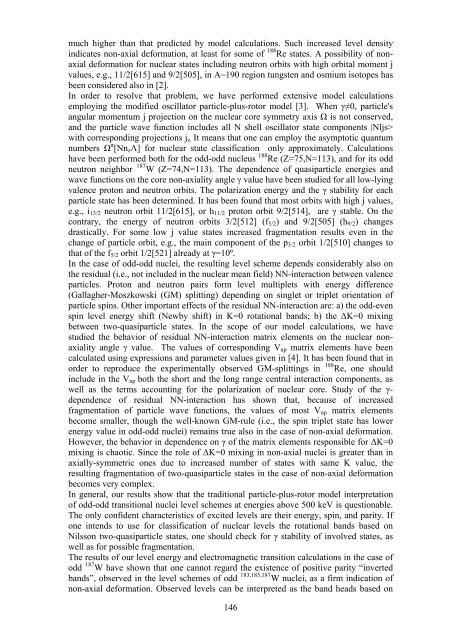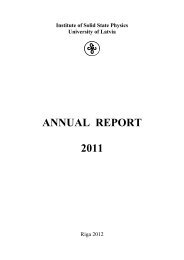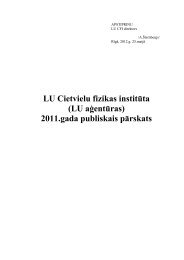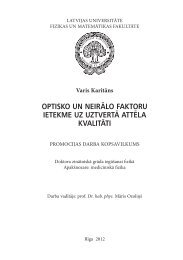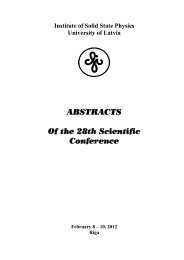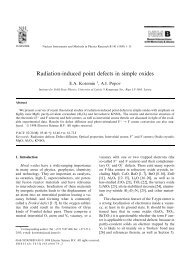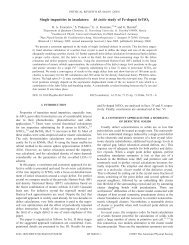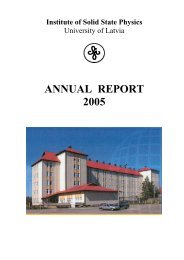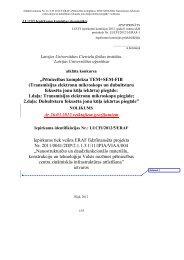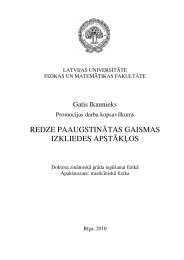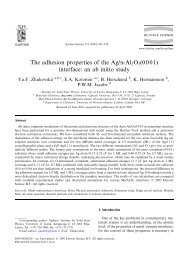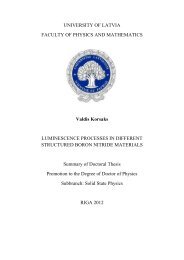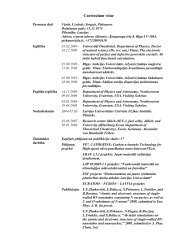Annual Report 2012 - Latvijas Universitātes Cietvielu fizikas institūts
Annual Report 2012 - Latvijas Universitātes Cietvielu fizikas institūts
Annual Report 2012 - Latvijas Universitātes Cietvielu fizikas institūts
Create successful ePaper yourself
Turn your PDF publications into a flip-book with our unique Google optimized e-Paper software.
much higher than that predicted by model calculations. Such increased level density<br />
indicates non-axial deformation, at least for some of 188 Re states. A possibility of nonaxial<br />
deformation for nuclear states including neutron orbits with high orbital moment j<br />
values, e.g., 11/2[615] and 9/2[505], in A~190 region tungsten and osmium isotopes has<br />
been considered also in [2].<br />
In order to resolve that problem, we have performed extensive model calculations<br />
employing the modified oscillator particle-plus-rotor model [3]. When γ≠0, particle's<br />
angular momentum j projection on the nuclear core symmetry axis Ω is not conserved,<br />
and the particle wave function includes all N shell oscillator state components |Nljs><br />
with corresponding projections j z. It means that one can employ the asymptotic quantum<br />
numbers Ω π [Nn z Λ] for nuclear state classification only approximately. Calculations<br />
have been performed both for the odd-odd nucleus 188 Re (Z=75,N=113), and for its odd<br />
neutron neighbor 187 W (Z=74,N=113). The dependence of quasiparticle energies and<br />
wave functions on the core non-axiality angle γ value have been studied for all low-lying<br />
valence proton and neutron orbits. The polarization energy and the γ stability for each<br />
particle state has been determined. It has been found that most orbits with high j values,<br />
e.g., i 13/2 neutron orbit 11/2[615], or h 11/2 proton orbit 9/2[514], are γ stable. On the<br />
contrary, the energy of neutron orbits 3/2[512] (f 5/2 ) and 9/2[505] (h 9/2 ) changes<br />
drastically. For some low j value states increased fragmentation results even in the<br />
change of particle orbit, e.g., the main component of the p 3/2 orbit 1/2[510] changes to<br />
that of the f 5/2 orbit 1/2[521] already at γ=10º.<br />
In the case of odd-odd nuclei, the resulting level scheme depends considerably also on<br />
the residual (i.e., not included in the nuclear mean field) NN-interaction between valence<br />
particles. Proton and neutron pairs form level multiplets with energy difference<br />
(Gallagher-Moszkowski (GM) splitting) depending on singlet or triplet orientation of<br />
particle spins. Other important effects of the residual NN-interaction are: a) the odd-even<br />
spin level energy shift (Newby shift) in K=0 rotational bands; b) the ΔK=0 mixing<br />
between two-quasiparticle states. In the scope of our model calculations, we have<br />
studied the behavior of residual NN-interaction matrix elements on the nuclear nonaxiality<br />
angle γ value. The values of corresponding V np matrix elements have been<br />
calculated using expressions and parameter values given in [4]. It has been found that in<br />
order to reproduce the experimentally observed GM-splittings in 188 Re, one should<br />
include in the V np both the short and the long range central interaction components, as<br />
well as the terms accounting for the polarization of nuclear core. Study of the γ-<br />
dependence of residual NN-interaction has shown that, because of increased<br />
fragmentation of particle wave functions, the values of most V np matrix elements<br />
become smaller, though the well-known GM-rule (i.e., the spin triplet state has lower<br />
energy value in odd-odd nuclei) remains true also in the case of non-axial deformation.<br />
However, the behavior in dependence on γ of the matrix elements responsible for ΔK=0<br />
mixing is chaotic. Since the role of ΔK=0 mixing in non-axial nuclei is greater than in<br />
axially-symmetric ones due to increased number of states with same K value, the<br />
resulting fragmentation of two-quasiparticle states in the case of non-axial deformation<br />
becomes very complex.<br />
In general, our results show that the traditional particle-plus-rotor model interpretation<br />
of odd-odd transitional nuclei level schemes at energies above 500 keV is questionable.<br />
The only confident characteristics of excited levels are their energy, spin, and parity. If<br />
one intends to use for classification of nuclear levels the rotational bands based on<br />
Nilsson two-quasiparticle states, one should check for γ stability of involved states, as<br />
well as for possible fragmentation.<br />
The results of our level energy and electromagnetic transition calculations in the case of<br />
odd 187 W have shown that one cannot regard the existence of positive parity “inverted<br />
bands”, observed in the level schemes of odd 183,185,187 W nuclei, as a firm indication of<br />
non-axial deformation. Observed levels can be interpreted as the band heads based on<br />
146


